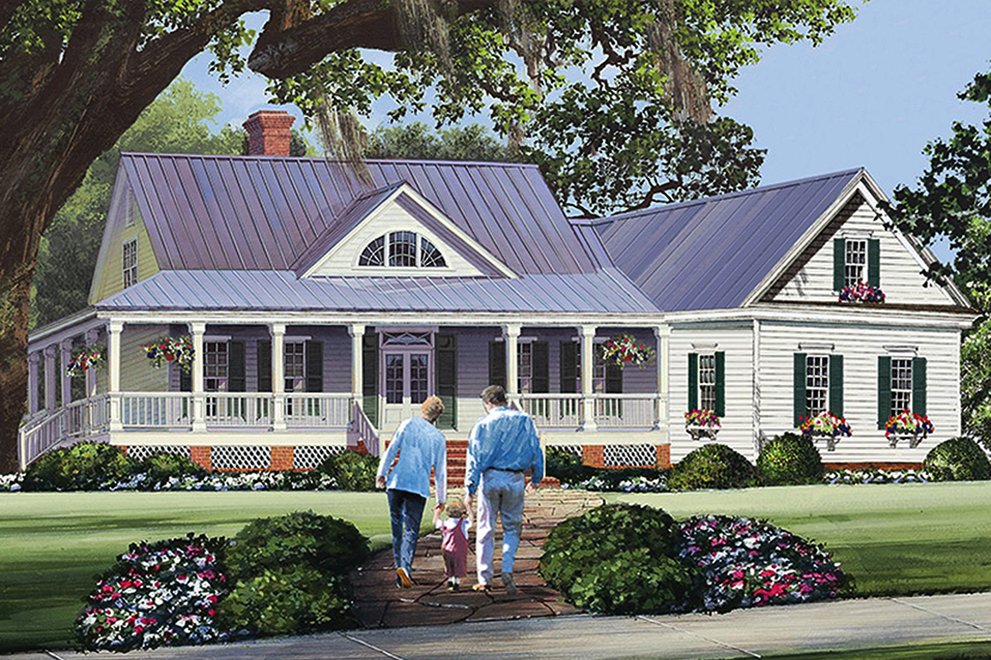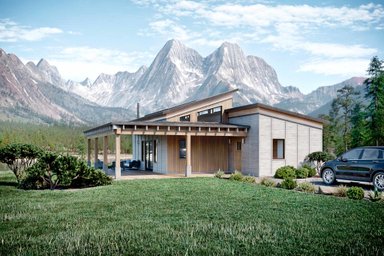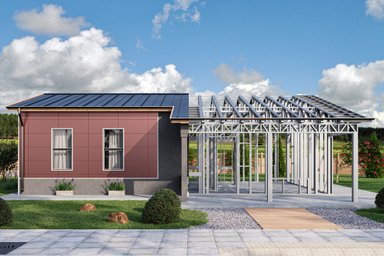When we see a beautiful photo of a house on Pinterest or in a home decoration magazine, they usually appear perfectly sited. Neighboring homes are rarely visible, telephone lines are obscured and you can’t feel the winter wind or the summer humidity. In real life the positioning of a house on a piece of property can dictate the difference between an so-so house and a great one. Here are 10 important things to concepts in mind when you are siting your new home. Think about these concepts, visit your site and talk to local builders and home owners before you decide what house plan to buy.
Setbacks
The first consideration is the “buildable envelope.” Many local codes specify that a house should be a minimum number of feet from each of the lot lines and any body of water. Countless dollars and hours are wasted planning and even buying plans for homes that don’t fit the buildable envelope.
If you are planning to add a well and septic system, these will have setbacks that will affect how and where you place the house on your land.
Neighborhood fit
There are two great reasons to consider the type and siting of nearby homes. First, a house that fits well with the neighbors creates a more coherent and desirable neighborhood. Second, older homes nearby may have evolved to fit the local conditions. Study neighboring homes to learn what works (and what doesn’t).
Views from inside
What do you want to see at breakfast? Can you see or be seen by neighbors? The placement of the house on the lot and the placement of rooms in the house should take into account views in and out.
Think about taking advantage of a down slope for what is usually called a “daylit basement" — that is, a basement floor with windows and doors facing down the slope. Does your site lend itself to the use of decks or porches for taking advantage of good weather?
Solar orientation
Some like to wake with the sun, others like to sleep in. Consider which rooms should be sunny at what times of day. In the Midwest you’ll want sun in the winter and shade in the summer. Direct south-facing windows may get too hot in the Summer. If you’re considering adding solar panels you’ll want to orient the panels south (in the Northern hemisphere) to capture optimal solar gain from the south. If you can’t face south west is second best.
Wind
Is your site windy? Where is the wind strongest/most sheltered? Trees, courtyards, walls… can all create comfortable places even on a windy site.
Landscape Elements
Tall hedges and trees can help break the wind and offer shade on hot days. Considering existing mature trees in your house siting may save you time and money. Also remember that smaller, immature trees near the house will grow up. Consider how will they will effect the light and warmth of the home as they grow.
Slope
If your lot has a slope you might want to consider drainage when you site your home. Shaping a lot, adding drainage and pumping sewage uphill to a sewer hookup can all add significant cost and complexity. Think about taking advantage of a down slope for what is usually called a “daylit basement" — that is, a basement floor with windows and doors facing down the slope.
Browse sloping lot plans here.
Hills
Consider the effect on evening sun and the emotional impact of living in front of or on top of a steep hill when siting a house on a steep lot. When you pick your plan, keep in mind that hill houses are designed differently than flat houses. Trying to make a flat lot house work on a hill may be more work than starting from a steep lot plan and modifying it to fit your tastes.
Sound
Loud neighbors and busy streets impact the experience and even the resale value of your home. Think about the source of noise and consider what part of the house faces the source, Since sound travels through windows more easily than walls, consider how many windows you want facing a noise source.
Future structures
Are you thinking about adding; a garden shed? a barn? an income unit or cottage for aging parents? even a chicken coop or bee hive? Consider the location of any future structures when you site your house. Let your site and its particular needs help teach you what plan to fall in love with. Starting with a specific house plan and trying to shoe-horn it into a site can cause heartache.
Talk to your local builder to talk through your siting ideas, and feel free to call our plan experts to find and customize a plan to fit your site.
Setbacks
The first consideration is the “buildable envelope.” Many local codes specify that a house should be a minimum number of feet from each of the lot lines and any body of water. Countless dollars and hours are wasted planning and even buying plans for homes that don’t fit the buildable envelope.
If you are planning to add a well and septic system, these will have setbacks that will affect how and where you place the house on your land.
Neighborhood fit
There are two great reasons to consider the type and siting of nearby homes. First, a house that fits well with the neighbors creates a more coherent and desirable neighborhood. Second, older homes nearby may have evolved to fit the local conditions. Study neighboring homes to learn what works (and what doesn’t).
Views from inside
What do you want to see at breakfast? Can you see or be seen by neighbors? The placement of the house on the lot and the placement of rooms in the house should take into account views in and out.
Think about taking advantage of a down slope for what is usually called a “daylit basement" — that is, a basement floor with windows and doors facing down the slope. Does your site lend itself to the use of decks or porches for taking advantage of good weather?
Solar orientation
Some like to wake with the sun, others like to sleep in. Consider which rooms should be sunny at what times of day. In the Midwest you’ll want sun in the winter and shade in the summer. Direct south-facing windows may get too hot in the Summer. If you’re considering adding solar panels you’ll want to orient the panels south (in the Northern hemisphere) to capture optimal solar gain from the south. If you can’t face south west is second best.
Wind
Is your site windy? Where is the wind strongest/most sheltered? Trees, courtyards, walls… can all create comfortable places even on a windy site.
Landscape Elements
Tall hedges and trees can help break the wind and offer shade on hot days. Considering existing mature trees in your house siting may save you time and money. Also remember that smaller, immature trees near the house will grow up. Consider how will they will effect the light and warmth of the home as they grow.
Slope
If your lot has a slope you might want to consider drainage when you site your home. Shaping a lot, adding drainage and pumping sewage uphill to a sewer hookup can all add significant cost and complexity. Think about taking advantage of a down slope for what is usually called a “daylit basement" — that is, a basement floor with windows and doors facing down the slope.
Browse sloping lot plans here.
Hills
Consider the effect on evening sun and the emotional impact of living in front of or on top of a steep hill when siting a house on a steep lot. When you pick your plan, keep in mind that hill houses are designed differently than flat houses. Trying to make a flat lot house work on a hill may be more work than starting from a steep lot plan and modifying it to fit your tastes.
Sound
Loud neighbors and busy streets impact the experience and even the resale value of your home. Think about the source of noise and consider what part of the house faces the source, Since sound travels through windows more easily than walls, consider how many windows you want facing a noise source.
Future structures
Are you thinking about adding; a garden shed? a barn? an income unit or cottage for aging parents? even a chicken coop or bee hive? Consider the location of any future structures when you site your house. Let your site and its particular needs help teach you what plan to fall in love with. Starting with a specific house plan and trying to shoe-horn it into a site can cause heartache.
Talk to your local builder to talk through your siting ideas, and feel free to call our plan experts to find and customize a plan to fit your site.






